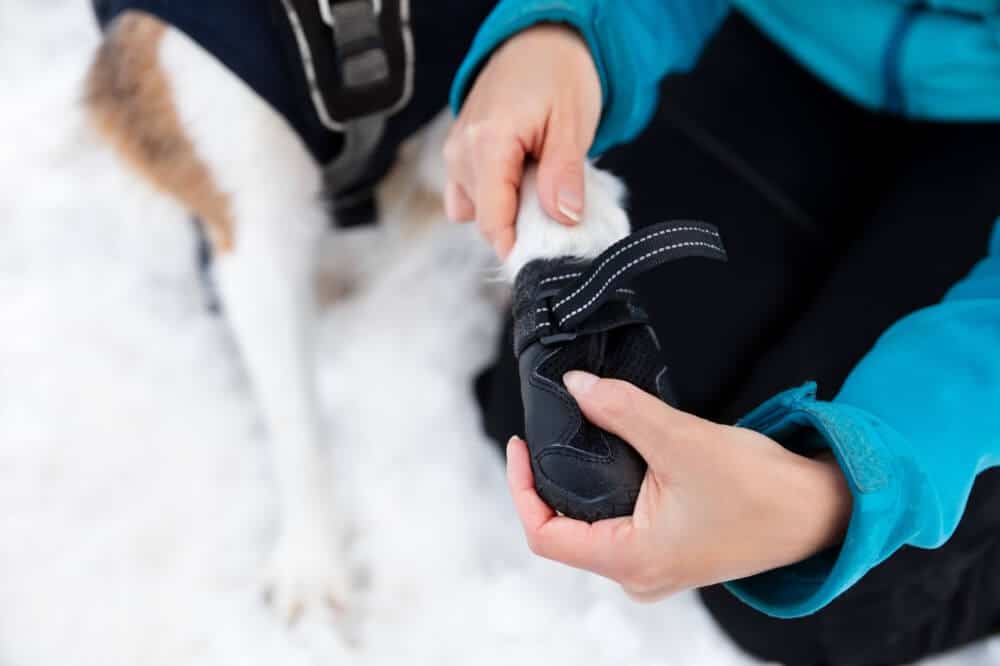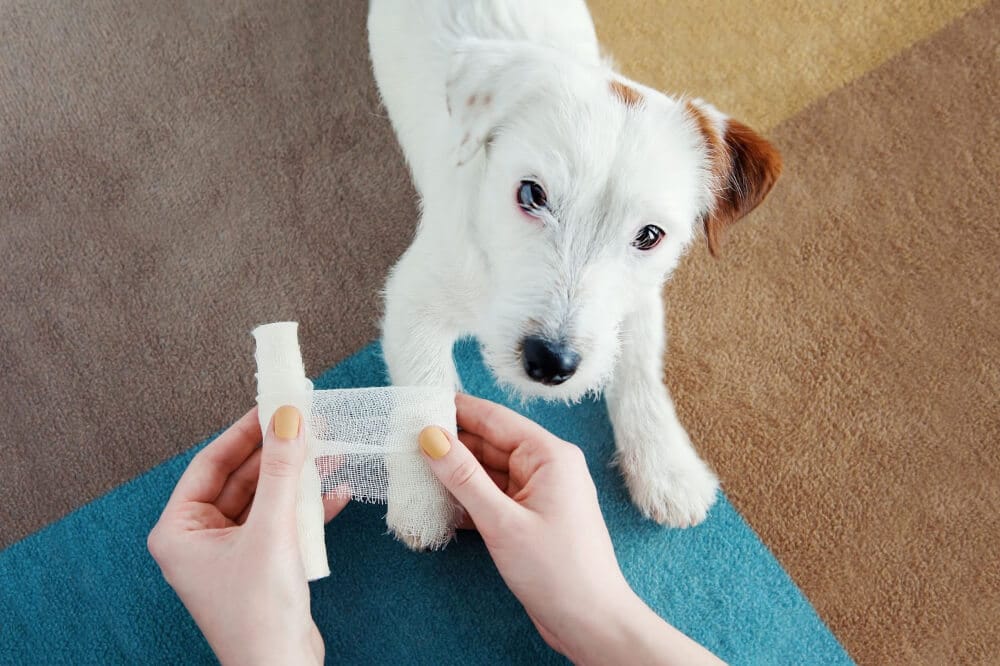I recently saw an episode that said dogs need about a 45-minute walk per day. Well, I started walking my miniature dachshund this week, but we have only walked about 20 minutes each day so far. I noticed today after our walk that she was licking her paws a lot, and I was concerned. I just looked at them again, and she now has a couple of blister-looking sores on her pads. What should I do to help her with the pain and make sure her paws heal properly?
Thanks,
Tamara Richardson
Boiling Springs, SC
Dear Tamara,
We see this problem fairly often during the hot summers in Atlanta. Dogs that haven’t been acclimated to hot pavement get blisters on their pads just like a human would walking without shoes. Dogs need to build up calluses just like people do. In the long run, taking it easy and slowly increasing the amount of time your dog walks on the pavement will allow those calluses to form. Once the blisters heal, you can still take the longer walks but on softer surfaces, such as grass, wooded ground, and underbrush, or with “booties” to protect the feet, only allowing cement walking for increasing time to grow the calluses.
We see this problem fairly often during the hot summers in Atlanta. Dogs that haven’t been acclimated to hot pavement get blisters on their pads just like a human would walking without shoes. Dogs need to build up calluses just like people do. In the long run, taking it easy and slowly increasing the amount of time your dog walks on the pavement will allow those calluses to form. Once the blisters heal, you can still take the longer walks but on softer surfaces, such as grass, wooded ground, and underbrush, or with “booties” to protect the feet, only allowing cement walking for increasing time to grow the calluses.
For now, keep the blisters clean with water. Do not use peroxide; it will slow the healing. Apply Neosporin twice a day until the sores heal. If you need pain medication, you should call your vet to see if they will send home a non-steroidal pain medication as the sores heal. Only very severe blisters require antibiotics, but you should consult your vet if you are unsure.
-Dr. Weaver
-Dr. Weaver
What To Do if You See a Blister On Your Dog's Paw
If you’ve ever taken your dog for a walk and spotted a suspicious-looking blister on its foot, you may have wondered what to do. You can find blisters on any part of your pup’s body, but they’re likely to form near hairless regions, such as the paws. While some are nothing to worry about, others can signify an infection or another problem. In this article, we’ll discuss how blisters occur on dogs’ paws and provide advice on dealing with them
How Do Dogs Get Blisters on Their Paws?
Dogs are susceptible to blisters on their footpads for the same reason humans are—friction. Their paws rub against the ground, creating friction and heat when walking, running, or playing. Over time, this can cause fluid to build up under the skin, resulting in a blister. This is a common issue for dogs because they are barefoot, especially if they walk on rough surfaces such as pavement or gravel. Here are some common reasons a pup will suffer from these awful sores.
Excessive Training
Dogs, just like humans, can develop blisters on their feet if they are running or walking for long periods. If you enjoy hiking with your pup and racking up some miles together, it’s best not to ignore any signs that he may have this condition!
Skin Aggravations
Your dog’s paws are delicate and need special care in the winter. The cold can cause blisters if they walk on salted roads or other chemical irritants, so clean the bottom of their paws as soon as possible after walking outside!
Hot Pavement
Walking your dog on hot pavement can be very dangerous. Not only does it cause blisters and burns to the paw pads, but walking an animal in this condition could also lead them to heatstroke, which is something you don’t want happening! If the ground is too hot for your feet or the back of your hand, then your furry friend should not go for a walk.
Cysts
Blisters and cysts can both look a lot like one another. If you’re not sure which it is, chat with your vet!
Allergic Reactions
How do you know if your pup has allergies? You can tell by the excessive licking of their paws, which leads to blisters developing and sometimes even infection! Consider checking for food or environmental allergies if you see them doing this more than usual.
Injury
The causes of blisters on your dog’s feet can be traumatic or due to an injury. One type, in particular, called a blood blister, will form if their paw pads get pinched by something sharp.
Harsh Grounds
One of the most common causes of blisters on a dog’s paw is walking through rough terrain. This can include hiking trails, rocks, gravel roads, areas with cracks in pavements, and construction sites with asphalt pavement, amongst other things!
How to Treat a Blister On Your Dog's Paw
Usually, you can treat your pup’s blister with an at-home first aid kit. Here are some ways to help alleviate the pain and allow the sore to heal quicker.
Wash
Keeping blisters clean will prevent infection. The first step is to wash with antibacterial soap and warm water, then thoroughly dry so that they don’t get infected.
Protect
To prevent infection and ensure a clean wound, wrap the paw with bandages to keep dirt out. If the blister bursts open, it needs immediate cleaning so bacteria can’t get in.
Avoid
To help your dog heal quickly, avoid rough terrain and hot pavement. If an irritant like chemicals caused the blister, stay away from those areas until it’s healed!
Prevent
It would be best to avoid allowing your dog to lick its paws while healing because it can lead to infection and cause more blisters.
Apply
To soothe an inflamed area, apply a Paw Soother or Nectar product. These contain ingredients designed for pain relief and prevention of infection.
How to Lessen the Risk of a Blister
Blisters on your dog’s paw can be painful and uncomfortable. If you suspect your dog has a blister, it’s essential to take preventative measures and treat it as soon as possible. Here are some tips for treating blisters.
Use Good Hygiene
Dog owners should ensure that their pup’s nails are trim and clean. Also, be sure to wipe them down after walks, especially in wintertime when they may have walked through some dirty snow or rain, which could irritate the skin on the feet! Keeping good hygiene will help reduce the risks of blisters/painful issues with your dog’s paws.
Plan Your Walks
To keep your dog safe and happy, you must be strategic about where he walks. Avoid exposure on hot or cold roads that are heavily salted, so they don’t burn the paws! Try walking in the grass when possible for minimal discomfort. Pay particular attention to the heat the summer sun can cause, and aim to do your long walks earlier in the day or later in the evening.
Check Paws Daily
Paws are a delicate part of their body, but they can also be an irritant if not cared for properly. Look out for signs that the skin is irritated, like redness or bleeding in between toes; a cracked paw pad with debris stuck beneath it (this will cause blisters). If you notice any of these things, take action immediately by removing any debris or irritant before more damage can happen!
Consider Boots
Boots are a great way to keep your dog safe from the elements and uneven terrain. Be sure they fit appropriately, or you might end up causing blisters on their feet!
Protect with Balm
Paw balms that can help protect paws from the elements and friction that can cause blisters is vital, especially when they spend time outside in harsh weather or on rough surfaces like asphalt roads. The balm provides relief by preventing drying out existing wounds and soothing any pain caused after an injury occurs.

When to Go to the Vet
If you have administered treatment at home for your pup’s blisters and notice any following symptoms, please reach out to your pet care provider.
Blisters Aren't Healing
If you notice that your pup’s blisters are not healing or getting worse after a few days, it could mean there is an issue with their condition. While some dogs heal faster than others, this delay may be due to age/health status, etc. If no improvement is visible, call the vet because they’ll know what steps to take next.
Swelling or Redness Around the Blister
The signs of an infection are redness or swelling around the blister, plus pus coming from within it. If you notice that your dog is lethargic and has a fever, there is cause for concern because these could be symptoms related to spikes in bacteria levels!
Blisters On Other Parts of the Body
If you notice your dog is developing additional blisters on other parts of its body, this could be an even more severe condition, and you should see a vet. They’ll determine the cause to create better treatment plans for it.
You Suspect a Cyst
If your dog has a cyst, contact your veterinarian for an evaluation. They may recommend various treatment options, depending on the type of cyst. In some cases, they may be able to drain the cyst and prescribe medication to prevent it from returning.











